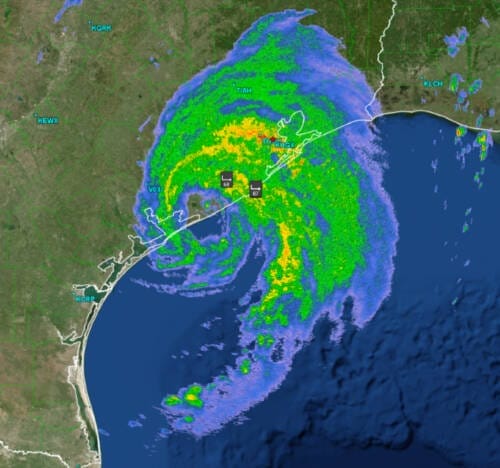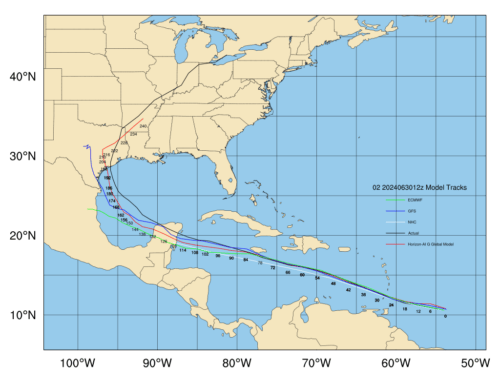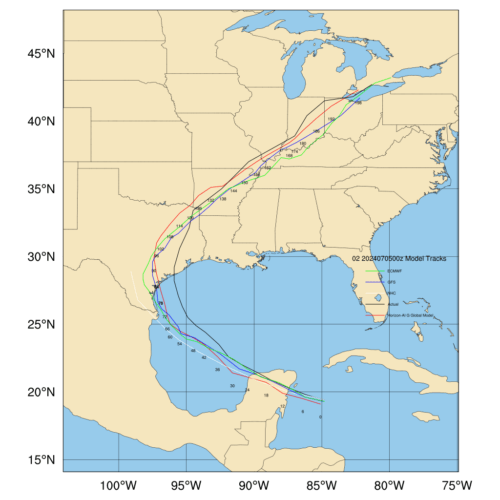Horizon AI Global Accurately Forecasts Beryl’s Track Nine Days Out
Hurricane Beryl’s landfall on July 8, 2024, caused great disruption, from flooding and flight cancellations to downed power lines and public health concerns amid extreme heat. The storm clocked in at a Category 1 Hurricane upon its landfall in Matagorda, Texas, with sustained winds of 80 mph. Climavision’s Horizon AI Global model proved to be a key tool enabling decision-makers to act upon the timeliest decisions with an unprecedented 213 hours (or approximately nine days) of lead time for a Texas landfall. This incredible feat far outpaces commonly used government models, as well as other competitors within the forecasting space who boast only 78 hours (or approximately three days) of lead time prior to landfall.

Beryl’s July 8th landfall (KHGX via GR2Analyst)
Hurricanes and Tracking Them
Before diving in, it’s important to briefly revisit what hurricanes are and the key factors involved in tracking them. A hurricane, also known as a tropical cyclone, is a rotating storm system characterized by strong winds, heavy rainfall, and low atmospheric pressure. Forming over warm ocean waters, hurricanes gain energy and strength as they absorb heat from the water’s surface. As they intensify, these storms can cause widespread destruction along coastlines and even far inland.
Tracking a hurricane’s formation and movement is essential because early detection allows for timely warnings and preparations. Understanding the key factors influencing hurricane paths, such as atmospheric pressure patterns, ocean temperatures, and wind currents, helps meteorologists predict the trajectory and potential impact of these storms more accurately.
Beryl’s Impact
Hurricanes can have a significant impact on a range of industries including energy utilities. CenterPoint Energy, for example, was feeling the heat following what some have called a slow response to the power outages created by Hurricane Beryl’s landfall. The Texas Tribune cited that, “Texans criticized the company for failing to prepare adequately for the storm, communicate clearly with customers, and restore power efficiently.” According to the news source, 2.6 million Texas homes and businesses were without power during peak outages. Also noted by the Associate Press, the storm took down a total of 10 transmission lines, cutting off the heartbeat of the utility system. Downed powerlines due to high wind and tree damage added to the issue at hand.
The utility provider’s struggle to prepare a timely response to storm related power outages highlights the necessity for companies to obtain, and utilize, high-quality forecast data as a prominent part of their resilience and mitigation strategy. Climavision’s Horizon AI suite of forecasting solutions, and Global model in particular, provide critical data that has proven a necessity for disaster preparedness and impact mitigation. Utility companies, emergency management groups, businesses, and more, can leverage accurate forecast data to best allocate resources to regions anticipating impact well ahead of landfall.
Horizon AI Global Model’s Beryl Track
Climavision’s Horizon AI Global forecast was the model most accurately aligned with Hurricane Beryl’s July 8th location of landfall, as seen from the forecast initialized on June 30th. Nine days before Beryl’s landfall, Horizon AI Global not only outpaced the GFS and ECMWF in precision of landfall location, but it also held a similar forecasted track to the actual outcome as Beryl’s remnants moved inland and took a northwestward turn. This is significant due to the near-record number of tornado warnings that were issued amid the storm’s wrath. Beryl officially stands as the tropical system with the second most tornado warnings upon landfall, with 203 tornado warnings issued in total.

Horizon AI Global – Tropical June 30th 12z Forecast
Many forecast models struggled on July 1st and 2nd to understand how the system would track following land interaction with Jamaica, and Beryl’s first official landfall expected shortly after on the Yucatan Peninsula. Understanding strength, organization, and the potential for the system to restrengthen was essential during this time period. By July 5th, many models had rebounded to forecasting a Texas landfall once again, but one model proved more accurate still: Horizon AI Global. Not only did the Global model hold closest to the actual track of Beryl, but it also outpaced the GFS, ECMWF, and the National Hurricane Center’s forecast track. On July 5th at 00Z, official NHC guidance displayed a track near the southernmost tip of Texas. Note: Horizon AI Global still forecasts a northeast turn upon landfall with the system, eventually leading up to the Great Lakes region which ultimately endured severe weather events, as well.

Horizon AI Global – Tropical July 5th 00Z Forecast
In addition to utilizing forecast track data, understanding wind speeds associated with a tropical system is vital to addressing the magnitude of damage to prepare for. Horizon AI Global provides important variables, like 10m Wind Speeds & Streamlines, to capture the strength of a hurricane upon landfall. On June 30th at 12Z, not only did Climavision’s Global model showcase the most accurate forecast track – it can also be seen below that winds of 70 knots (or ~80 mph) were forecasted with this system’s landfall. According to BVK Energy, wind speeds of that magnitude, indicating a Category 1 hurricane, can damage power infrastructure and result in power outages that can last several days. A forecast with this kind of precision at nine days out from landfall should help utility providers keep a close eye on the forecast track and storm strength as it evolves, enacting preparedness plans and mitigation strategies as confidence in landfall increases.

Horizon AI Global 10m Wind Speed & Streamlines (kts) June 30th 12Z
The Horizon AI Global Advantage
Data observations are important in not only assessing a tropical system’s strength and organization in real time, but also provide forecast modeling with the information needed to accurately predict future storm motion and strength. Horizon AI Global ingests over 1.5 billion unique data observations a day. Targeted Artificial Intelligence (AI) to improve data assimilation and quality control pushes Global to greater heights in precision and accuracy.
Stay Ahead of Hurricanes
When forecasting tropical systems, there are many elements at play. Between land interaction, influence of other weather systems, weather conditions such as wind shear, and more, having a reliable model that can work through possible development scenarios in the most accurate fashion is important. The greater lead time a forecast can provide, and the more consistency to support confidence in a landfall location, both benefit decision makers in preparation for impending events, and ultimately leads to more resilience and disaster mitigation. If you’d like to learn more about Horizon AI Global’s advanced hurricane tracking capabilities, contact us.






